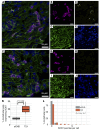Increased endothelial sclerostin caused by elevated DSCAM mediates multiple trisomy 21 phenotypes
- PMID: 38828726
- PMCID: PMC11142749
- DOI: 10.1172/JCI167811
Increased endothelial sclerostin caused by elevated DSCAM mediates multiple trisomy 21 phenotypes
Abstract
Trisomy 21 (T21), a recurrent aneuploidy occurring in 1:800 births, predisposes to congenital heart disease (CHD) and multiple extracardiac phenotypes. Despite a definitive genetic etiology, the mechanisms by which T21 perturbs development and homeostasis remain poorly understood. We compared the transcriptome of CHD tissues from 49 patients with T21 and 226 with euploid CHD (eCHD). We resolved cell lineages that misexpressed T21 transcripts by cardiac single-nucleus RNA sequencing and RNA in situ hybridization. Compared with eCHD samples, T21 samples had increased chr21 gene expression; 11-fold-greater levels (P = 1.2 × 10-8) of SOST (chr17), encoding the Wnt inhibitor sclerostin; and 1.4-fold-higher levels (P = 8.7 × 10-8) of the SOST transcriptional activator ZNF467 (chr7). Euploid and T21 cardiac endothelial cells coexpressed SOST and ZNF467; however, T21 endothelial cells expressed 6.9-fold more SOST than euploid endothelial cells (P = 2.7 × 10-27). Wnt pathway genes were downregulated in T21 endothelial cells. Expression of DSCAM, residing within the chr21 CHD critical region, correlated with SOST (P = 1.9 × 10-5) and ZNF467 (P = 2.9 × 10-4). Deletion of DSCAM from T21 endothelial cells derived from human induced pluripotent stem cells diminished sclerostin secretion. As Wnt signaling is critical for atrioventricular canal formation, bone health, and pulmonary vascular homeostasis, we concluded that T21-mediated increased sclerostin levels would inappropriately inhibit Wnt activities and promote Down syndrome phenotypes. These findings imply therapeutic potential for anti-sclerostin antibodies in T21.
Keywords: Bone development; Cardiology; Cardiovascular disease; Genetic diseases; Genetics.
Figures




References
MeSH terms
Substances
Grants and funding
- UM1 HL098123/HL/NHLBI NIH HHS/United States
- U01 HL098162/HL/NHLBI NIH HHS/United States
- T32 HL007572/HL/NHLBI NIH HHS/United States
- U01 HL153009/HL/NHLBI NIH HHS/United States
- T32 HL007208/HL/NHLBI NIH HHS/United States
- UM1 HL098166/HL/NHLBI NIH HHS/United States
- UM1 HL128761/HL/NHLBI NIH HHS/United States
- UM1 HL128711/HL/NHLBI NIH HHS/United States
- UM1 HL098147/HL/NHLBI NIH HHS/United States
- R01 HL151257/HL/NHLBI NIH HHS/United States
- U01 HL128711/HL/NHLBI NIH HHS/United States
- UM1 HL098162/HL/NHLBI NIH HHS/United States
- U01 HL131003/HL/NHLBI NIH HHS/United States
- R03 HL150412/HL/NHLBI NIH HHS/United States
- K08 HL157653/HL/NHLBI NIH HHS/United States
- U01 HL098147/HL/NHLBI NIH HHS/United States
LinkOut - more resources
Full Text Sources
Medical
Molecular Biology Databases
Research Materials

